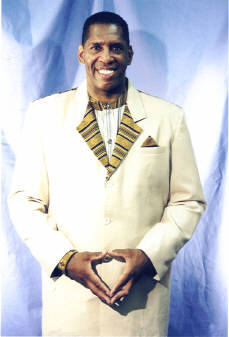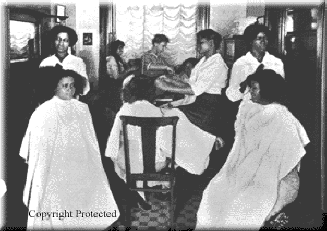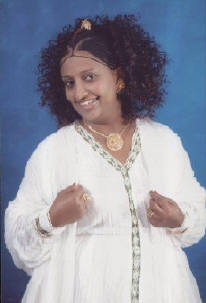We have thus far presented the worlds most indept Thesis on the phenomena of "Good Hair" but this Lecture has just begun because any lecture on Good Hair would have to be inclusive of the Amazing Country of Ethiopia where good hair is natural.
The Buddhist Gosho reads; "only Buddhas know the
“True entity of all phenomena..
the nature, form true entity...... This passage explains the Ten aspects of all phenomena."
Ethiopia is known as the land of Culture and History and a place where the first human was found. Moreover Ethiopia is the land in Africa where you will find almost the exact phenotype of any African in America or a copy of any African/American female with only one exception; "most of the African/American women wear weave and extentions while many of the Ethiopian women have the exact natural hair that the African/American woman insert into her head as weave.
Ethiopia is the only African nation that has never been colonized, they have a cultured history of dealing with their hair for thousands of years. We in Buddhism deal with the law of cause and effect and all phenomena is govern by this law. When Africans arrived in America they came as slaves and we noted that the slave masters cut the hair of both men and women.
While America had slavery all other African countries were subjected to colonization and Africans and African/Americans defined their hair styles based upon that of the slave and colonial masters. Slaves in America used axle grease, butter, lye heated knives and actually Irons as a way to straighten their their hair.
We showed that it was not until the 1900's with the development of products from entreprenuers like Madame C. J. Walker that products for grooming African/Americans were just evolving and being developed. It was not until the 1900's that the first comostology schools were developed to teach African/Americans how to care and groome themselves. More important it was after slavery in America where the goal was to have "good hair" and the culture of straight hair evolved in America.
Less than 50 years after slavery in America the manifestation of the Black hair business emerged in America and the concept of the "Good Hair"Schools made their appearance.
This is one of the artist drawn horrific pictures of "Colonialism in Africa whereas Africans are protrayed as backward savages waiting on slavemasters to come and educate them to the white ways of society
.
The Buddha writes; "All phenomena manifest its true entity 1. Appearance 2. Nature 3. Entity 4. Power 5. Influence 6. Inherent Cause. The idea that one's hair must be straight has within it 6. an "Inherent Cause" that has 7. Relationship that has a 8. Latent effect that has 9. Manifest an effect that leads to 10. to an exact consistency from beginning to the end. This phenomena will manifest any of the ten worlds and three realms of existence.
It is a clear-cut reality that the 1. Appearance 2. Nature of "Good Hair" was based on the world of Animality or dominance of one people over another and the 3. Entitity would manifest a 4. Power and 5. Influence different in Ethiopia than that of America based on it "Nature and 6.. Inherent cause to the 7. Relationship to 8. Latent Effect to 9. Manifest Effects to the Consitency for begging to the end.
The Ethiopian people have never been colonized and they have not only a "Written History" of it culture but to this very day there are Tribes and cultures in old and primitive Ethiopia that have maintained there hair styles for Thousands of years.
This is a picture of the Afro worn by the Afar people. Ths man would have no need to put a dangerous chemical relaxer in his hair.
This Afro worn by H. R. Brown in America emerged in the 1960's as a statement or rebellion against racism and predudice in America. The Afro was common in Ethiopia.
Men usually have a hair style in the Afro fashion. However, they are known to also braid their hair. A well known examples of braids in men is that of Emperor Tewodros and Yohannes. This style is common among the Amhara of Ethiopia depicted on the left.
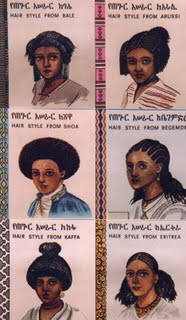
Many types of hair styles exists in Ethiopia. Basically, braids (sheruba in Amharic), Afros (Goferay in Amharic) and dreadlocks of monks and pilgrims are common. In major towns however, the wonderful styles are not seen as common as in the rural areas. Most Ethiopians may proudly hang up photos of traditional hair styles in their homes but usually avoid wearing it themselves probably because they may be depicted as backwards. Many years ago The Ethiopian Post Office printed a set of stamps that depicted various tribes wearing unique and stylistic hair styles from the provinces of Arussi, Bale, Begemedir (Gonder), Eritrea, Shoa and Kaffa (double click for larger image). Some of these hair styles were actually used by the ancient Egyptians and Pharoahs and people of the Nile Basins. In fact there are many traditions and cultures used in Ethiopia that are presently absent in other parts of the Nile valley such as Head Rests, Cistrums, Ear wax cleaners and reed Rain Coats are still used in Ethiopia. Interestingly, the Ice Man found in the Alps of Italy used a similar Reed Rain Coat though he used it as a sleeping mat as do the Ethiopians! The hair styles shown here are from the stamps printed many years ago by the Ethiopian Post Office
Some of the Hair Styles that we see in America have a history in Ethiopia Thousands of years ago even the ancient egyptians wore some of the hair styles found in Ethiopia. Ethiopia gives African/Americans a clear-cut historical view of Black hair.
In America we see this hair style that was worn by Ethiopian Emperor Tewodros. This was an Emperor who communicated with the Queen of England. They had a culture and kingdoms and castles.
The Word Sheruba means hair braided or in Corn Rolls
The pictures on the left and right are historical pictures from the Tewdros Ethiopian Library. The picture of the woman in the center after getting an expensive Sheruba hair style. This effort takes 4 to 5 hours and lasts 3 to 4 weeks. The culture in Ethiopia althought there are 80 million Black people it would be rare to find a saloon where you can get chemically processed hair. Straighten combs or curlers yes but chemicals for young girls hair as in America is unheard of.

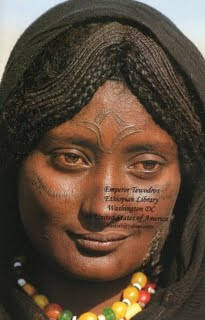
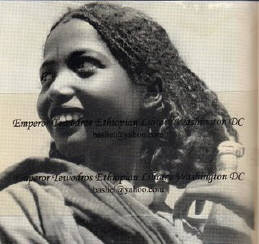
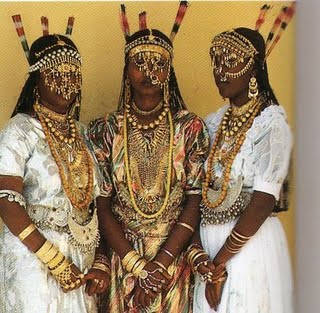
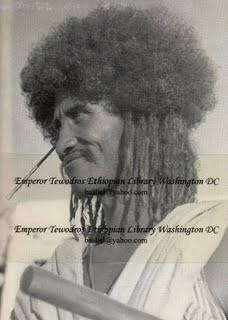
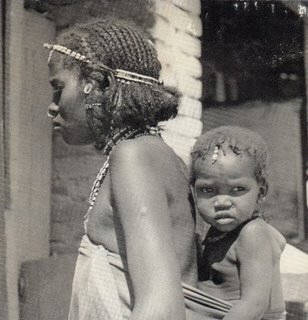
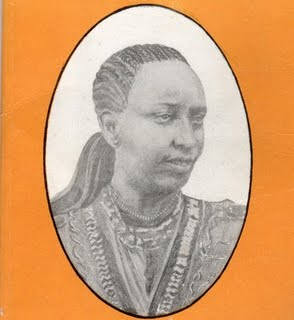
Taytu Betul (or Taitu) was born in or around 1851,
[
1
]
the third of four children in an aristocratic Ethiopian family that was related to the Solomonic dynasty. Her father, Ras Betul Haile Maryam was less well known than her uncle Dejazmach Wube Haile Maryam, who was the ruler of much of Northern Ethiopia in the 1840's, and a rival of Emperor Tewodros II. Her father's family were the ruling family of Semien province, claiming descent from Emperor Susenyos. Her father's mother was a daughter of Ras Guga, a member of the powerful ruling family of Yejju, which was of Oromo origin and had converted to Christianity from Islam, and which had ruled as Regents for the powerless Emperors in Gondar during the Zemene Mesafint ("Era of the Princes"). Taytu's mother Yewubdar was from a minor noble family of Gondar. Taytu had the reputation of being fiercely proud of her lineage in Yejju, Semien and Begemder. After four failed marriages, Taytu Betul married King Menelek of Shewa, later Emperor Menelek II of Ethiopia.
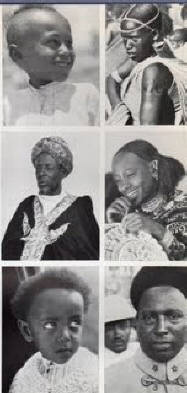
Hair styles also exists for the young. Mischievous toddlers receive a Mohawk type of hair cut. The Amharic name for this style is "Kuntcho". The traditional story behind this style is that the angels will pull the kids out of trouble by holding onto the tuft of hair of the kids. An example is the kid on the left. Young girls receive a hair cut that includes a shaved top surrounded by a halo of an Afro style. The girl on the left probably has this type of hair style but whether the top is shaved is not visible
Combination of an Afro and Lock hair style.
This is a picture of Afar women with the braids
-
Mertu: This hairstyle is traditional amongst the Ethiopian Oromo people. The hair is braided in a rope-like fashion (twisted around) and ends in a tuft.
This is an Afar braided Style
Common Braided hair style in Ethiopia
This is a cultural style in Ethiopia of women braiding their childrens hair as opposed the the harse chemicals of trying to produce "Good Hair".
We showed you traditional styles of Ethiopian hair Style let us examine modern Ethiopian hair styles




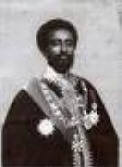
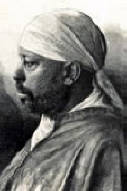
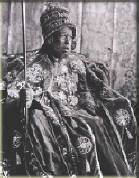
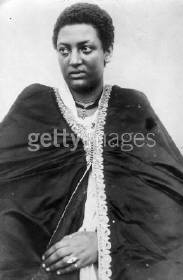
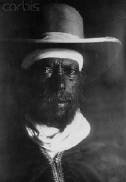
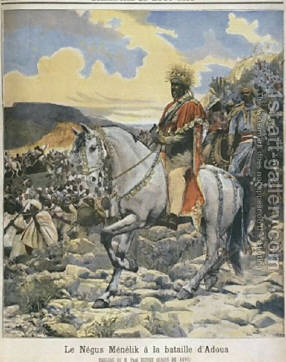
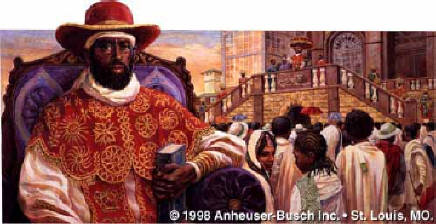
Menelik II
, 1844-1913, emperor of Ethiopia after 1889. He was originally ras (ruler) of Shoa (central Ethiopia). After the death (1868) of Emperor Tewodros II, Menelik, with Italian support, gained strength steadily. He seized the throne after Emperor Johannes IV died. In 1889, Menelik concluded the Treaty of Uccialli with Italy. When he learned, however, that the Italian version of the treaty made Ethiopia a protectorate of Italy, he denounced the agreement. The Italian invasion that followed (1895-96) was crushed by Menelik's great victory near
Adwa. Italy was forced to renounce all claim to Ethiopia and to pay an indemnity. Menelik took important steps to strengthen and modernize his domain. He made Addis Ababa his capital, constructed a railroad, attempted to end the slave trade, and curbed the feudal nobility. His conquests doubled the size of the country and brought the present S Ethiopia (largely Muslim in population) into the realm. Gradually his health failed, and the end of his reign was marked by intrigue and maneuvering for the succession. He was succeeded as emperor by Lij Yasu
Look at the hair of the Great Ethiopian Emperor Menilik II
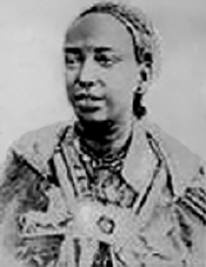
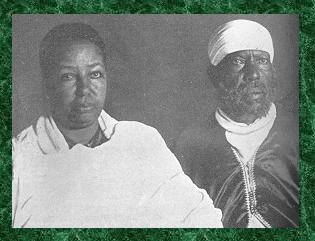
Taytu is acknowledged to have wielded considerable political power as the wife of Menelik, both before and after they were crowned Emperor and Empress in 1889. She led the conservative faction at court that resisted the modernists and progressives who wanted to develop Ethiopia along western lines and bring modernity to the country. Deeply suspicious of European intentions towards Ethiopia, she was a key player in the conflict over the Treaty of Wuchale with Italy, in which the Italian version made Ethiopia an Italian protectorate, while the Amharic version did not do so. The Empress held a hard line against the Italians, and when talks eventually broke down, and Italy invaded the Empire from its Eritrean colony, she marched north with the Emperor and the Imperial Army, commanding a force of cannoneers at the historic Battle of Adwa which resulted in a humiliating defeat for Italy in March, 1896. Menelik, who often prevaricated and postponed unpleasant decisions with answering "Yes, tomorrow" (Ishi, nega), found it useful to have his wife be in a powerful enough position to say "Absolutely not" (Imbi) to people and issues he just didn't want to personally offend or refuse.
[
2
]
As a result, Empress Taytu was increasingly unpopular while Menelik remained very loved by one and all at court.
